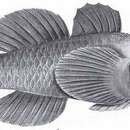pt-BR
nomes no trilho de navegação


Dixson and Hay (2012) documented a remarkable mutualistic relationship between the staghorn coral Acropora nasuta and the Redhead Goby (Paragobidon enchinocephalus), which is recruited by the coral to keep it free of Turtleweed (Chlorodesmis fastigiata). Within minutes of Turtleweed (or even a chemical extract from the Turtleweed) contacting the coral, the coral releases an odor that recruits gobies to trim the Turtleweed and dramatically reduce coral damage that would otherwise occur. Interestingly, in contrast to the other goby species shown to play a similar role (the Broad-barred Goby, Gobiodon histrio) the Redhead Goby does not consume the Turtleweed it removes.
The Redhead Goby,Paragobiodon echinocephalus, is a small fish with a black body and fins and a large red-orange head that is covered in soft, short bristles.It is found in coral reefsfrom the Red Sea and Madagascar in the West to Japan, Polynesia and Australia in the East (Herre 1936, Masuda et al. 1984,Randall et al. 1990,Allen & Adrim 2003). This gobyinhabits live heads of scleractinian corals, in particular, thehood coral, Stylophora pistillata(Kuwamura et al. 1994a, Herler & Hilgers 2005,Belmaker et al.2007, Herler 2007). It has also been found in association with the cauliflower coral,Pocillopora damicornis(Lassig 1977) and the small staghorn coralAcropora nasuta(Dixson & Hay 2012). The fishes rely on their coral host for food, shelter from predation, and breeding sites.
Redhead gobies may live in a coral singly, in pairs, or in groups, with larger coral generally hosting larger groups of fishes. Within an individual coral, only the largest two fish will breed(Kuwamura et al. 1993). After the female spawns on the coral, the father will guard the eggs until they hatch(Kuwamura et al. 1993).
Like many reef fishes, redhead gobiesare capabable of changing sex (sequential hermaphroditism). But unlike most sequential hermaphrodites who change sex only once during their lifetime,P. echinocephalusmay change sex repeatedlyin either direction (Nakashima et al. 1995). In fact, the phenomenon of multiple changes from female to male or male to female (serialhermaphroditism) was first described in this species (Kuwamura et al. 1994b).
New research reveals that corals send out chemical signals to recruit the help of Goby fish in removing toxic seaweed.
Paragobiodon echinocephalus és una espècie de peix de la família dels gòbids i de l'ordre dels perciformes.
És un peix marí, de clima tropical i associat als esculls de corall.[4][6]
Es troba des del Mar Roig i l'Àfrica Oriental fins a les Illes Marqueses, les Tuamotu, les Illes Ryukyu i l'Illa de Lord Howe.[4][7][8][9][10][11][12][13][14][15][16][17][18][19][20][21][22][23][24][25][26][27][28][29][30][31][32][33][34][35][36]
És inofensiu per als humans.[4]
Paragobiodon echinocephalus és una espècie de peix de la família dels gòbids i de l'ordre dels perciformes.
Paragobiodon echinocephalus es una especie de peces de la familia de los Gobiidae en el orden de los Perciformes.
Los machos pueden llegar alcanzar los 4 cm de longitud total.[1]
Es monógamo.
Es un pez de Mar y, de clima tropical y asociado a los arrecifes de coral.
Se encuentra desde el Mar Rojo y el África Oriental hasta las Islas Marquesas, las Tuamotu, las Islas Ryukyu y la Isla de Lord Howe.
Es inofensivo para los humanos.
Paragobiodon echinocephalus es una especie de peces de la familia de los Gobiidae en el orden de los Perciformes.
Paragobiodon echinocephalus Paragobiodon generoko animalia da. Arrainen barruko Actinopterygii klasean sailkatzen da, Gobiidae familian.
Espezie hau Agulhasko itsaslasterran aurki daiteke.
Paragobiodon echinocephalus Paragobiodon generoko animalia da. Arrainen barruko Actinopterygii klasean sailkatzen da, Gobiidae familian.
Paragobiodon echinocephalus is een straalvinnige vissensoort uit de familie van grondels (Gobiidae).[1] De wetenschappelijke naam van de soort is voor het eerst geldig gepubliceerd in 1830 door Rüppell.
Bronnen, noten en/of referenties棘头副叶鰕虎鱼(学名:Paragobiodon echinocephalus)为鰕虎鱼科副叶鰕虎鱼属的鱼类,俗名副叶虎鱼。分布于红海、印度洋非洲东南岸至太平洋中部土阿莫土群岛、北至日本以及西沙群岛、海南岛等,属于暖水性近岸鱼类。其常栖息于珊瑚丛中。该物种的模式产地在马萨瓦、红海。[1]
棘头副叶鰕虎鱼(学名:Paragobiodon echinocephalus)为鰕虎鱼科副叶鰕虎鱼属的鱼类,俗名副叶虎鱼。分布于红海、印度洋非洲东南岸至太平洋中部土阿莫土群岛、北至日本以及西沙群岛、海南岛等,属于暖水性近岸鱼类。其常栖息于珊瑚丛中。该物种的模式产地在马萨瓦、红海。